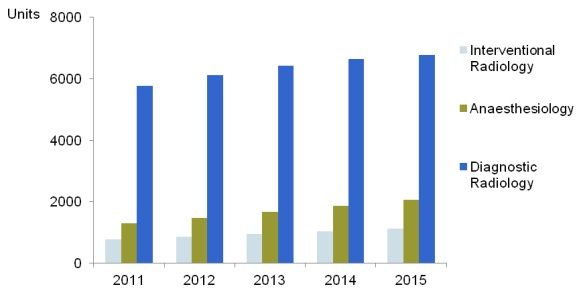- AI
- Molecular Imaging
- CT
- X-Ray
- Ultrasound
- MRI
- Facility Management
- Mammography
Ultrasound in Interventional Radiology: Small Market, Big Future
With increasing economic pressures and concern regarding radiation dose, a safer and comparable alternative to CT and X-ray is being sought. Ultrasound may be the answer.
For many manufacturers, advancing ultrasound use in radiology has been a challenge. While new technologies have driven ultrasound use in other applications, such as heart wall motion diagnostics in cardiology and 3D/4D volume imaging in OB/GYN, many radiologists continue to use ultrasound for basic examinations only.
Nevertheless, recent advances in image quality, improved workflow, and rising concerns over radiation dose in other modalities, are re-igniting radiologist’s interest in ultrasound.
The interventional radiology (IR) market only accounted for 3 percent of global ultrasound revenues in 2011, according to InMedica, an independent market research firm, but has great future growth potential. Computed tomography and X-ray have been most widely used for IR procedures, on account of the clarity and resolution of the image guidance provided. With increasing economic pressures and concern regarding radiation dose, a safer and comparable alternative is being sought. Ultrasound may be the answer.
Fusion imaging is the key technology driver in the IR market. The incorporation of new advanced GPS positioning enables real-time feedback of needle position during interventional procedures, allowing highly accurate guidance. These advances in ultrasound procedural guidance are improving both the efficiency and quality of the procedure, providing further cost savings for hospitals.
The anaesthesiology sector is an example of how improved image quality, flexibility and favorable costs have driven increased use of ultrasound. While growth of the overall radiology ultrasound market remains slow, ultrasound in the IR market has potential to have the same success as in anaesthesiology, in which global unit shipments have grown between 10 percent and 15 percent annually in the last three years.
Recent developments in cardiac care have also led to new therapies integrating interventional and surgical procedures. Hybrid operating suites are used for these procedures, combining the conventions of a surgical operating room with imaging technology, such as X-ray, CT, MRI and ultrasound equipment. The increased use of hybrid interventional suites in developed and mature healthcare markets is driving initial demand and use of ultrasound equipment in IR.
Furthermore, technological advances in minimally invasive surgery are leading to greater need for imaging procedural guidance. Hybrid suites also have benefits for healthcare providers. In combining imaging with surgical suites, hospitals are able to reduce costs and increase efficiency. The patient is not subjected to multiple operations, the length of stay is reduced, and the overall cost of care is lower.
Hybrid suites are a major investment for hospitals, typically costing several million dollars. Yet, adoption of hybrid suites in the U.S. is already common. In the short term current economic concerns will limit wider penetration in other mature markets, due to economic concerns and healthcare expenditure freezes. Longer term, use of these suites in large hospitals will significantly increase in the next three to five years, due to the increased return on investment provided.
The increasing image quality, flexibility and cost savings offered by ultrasound will drive growth in the IR market. InMedica forecasts revenue growth between 4 percent and 6 percent globally for interventional radiology in 2012. Optimising technology of ultrasound fusion imaging may help to further drive growth in this market.
However, the on-going challenge in the IR market is convincing healthcare providers of the benefits of ultrasound, both in cost and quality of care. The clinical cost benefits associated with ultrasound have already been proven within other ultrasound applications; if the same can be done in IR, interventional ultrasound will quickly become standard practice.

U.S. Ultrasound Units by Application. Source: InMedica
Carly Reed is an analyst at InMedica, working within the medical imaging research group. Carly is responsible for the report, “The World Market for Ultrasound Imaging Equipment – 2012”, due to be published in April 2012.
European Society of Breast Imaging Issues Updated Breast Cancer Screening Recommendations
April 24th 2024One of the recommendations from the European Society of Breast Imaging (EUSOBI) is annual breast MRI exams starting at 25 years of age for women deemed to be at high risk for breast cancer.
Study Reveals Benefits of Photon-Counting CT for Assessing Acute Pulmonary Embolism
April 23rd 2024In comparison to energy-integrating detector CT for the workup of suspected acute pulmonary embolism, the use of photon-counting detector CT reduced radiation dosing by 48 percent, according to newly published research.
